Childhood memories of avurudu

The family home: Dehigama walauwwa in Meewatura
The Aluth Avuruddha (New year) is a time for celebration, revelry and bonhomie. Even though there are the inevitable changes with the times in preparing for the dawn of the New Year and its celebrations, there are still some age-old customs and practices followed, mainly in the villages.
I remember during my childhood living in my grandparents’ Dehigama walauwwa- Arambe in the village of Meewatura close to Peradeniya, the villagers visited us daily and during Avurudu time they played an important role in making the sweetmeats and helping in other work in the house. The men whitewashed and cleaned the house. The hearth was repaired and cow-dung was applied. My brothers and I walked around the house observing everything that was happening and very often we were told- “duwanna, gihin sellam karanna” (run away and play).
It is the season after the paddy harvest when people get ready to celebrate the new year. Pusumbi and her daughter came to pound the paddy and it was wonderful to see them using the pestle, rhythmically lifting and bringing it down. Then there were other women, making the sweetmeats kevun, athirasa, unduvel, mung kevun, aluva, hendi kevun, achchu kevun, kokis etc. The women came home a day or two before the new year to prepare these sweetmeats.
The treacle and jaggery were made with the Telijja brought earlier by Andiris. Dingiri Menika made the konda kevun (oil cakes). She made a lipa (a hearth) with three stones or bricks right in the middle of the kitchen. After worshipping and muttering something with her hands together in worship, she would place the thachchi (wok) with the oil. A spoonful of the batter was put into the boiling oil. When half cooked, she would take a clean ekel and inserting it into the kevun, twist it around to make a lump appear at the top (a kondaya)! We would look at it in wonder. Sometimes we would grab a kevun and run off with it. She shouted but there was always a smile. Heen Menika (we called her HM) made the kokis.
The day before the Avurudu, people bathed applying lime on their head to clean themselves. Grandmother placed sweetmeats in a vatti (open flat baskets) and distributed them to all the households irrespective of caste and creed. With that the Parana Avuruddha ended.
The New Year begins with the transition of the Sun from the house of Pisces to the house of Aries( Meena Rashiya to Mesha Rashiya). Almost all the houses had an Epa Panchanga litha (Sinhala Almanac) and people followed all the rituals/customs according to the auspicious times mentioned in it. There is a time to complete all the work and then comes the Nonagathé or punyakalaya. It is believed to be the time when astral bodies are not active, but only the evils ones are active. At this time people go to the temple and at home, play indoor games such as Olinda or Bello Demeema. Young ones are on swings or play outdoor games.
When the Aluth Avurudu Nekatha dawned, crackers were lit for the whole village to be aware to follow the other rituals. The temple bells would ring to indicate the dawn of the New Year. Women played the rabanna. The hearth was lit to cook milk-rice. At the same time a pot of milk was boiled with family members seated round the makeshift hearth in the hall. I remember grandmother dropping a coin into the well. Thereafter, the younger children would worship the elders, offering bulath (betel leaves) to show their respect and gratitude. They in turn would bless the younger ones. Gifts were exchanged. New clothes were worn.
Veda Alleema was when they do some work – children read books, women cut vegetables or attended to some task in the kitchen). Ganu-denu (exchanging of money wrapped in a betel leaf) was another activity. During Avurudu time the betel leaf and water play an important part in most of the activities.
There is also a day marked for hisa-thel geme (anointing). This is mainly done in the village temple by the chief monk. At home, grandfather applied the oil.
With people going to work at an auspicious time, customs and rituals end for the Aluth Avurudu celebrations.
Relatives are visited with sweetmeats and other gifts. Some take rice and curry in a kurini petti (a woven box). Relationships are renewed. Aluth Avurudu celebrations are an important part of the life of people.
Searching for an ideal partner? Find your soul mate on Hitad.lk, Sri Lanka's favourite marriage proposals page. With Hitad.lk matrimonial advertisements you have access to thousands of ads from potential suitors who are looking for someone just like you.


